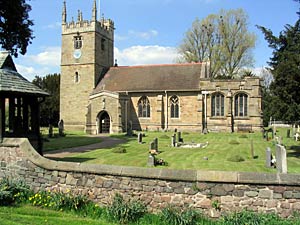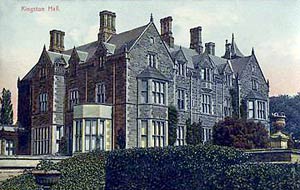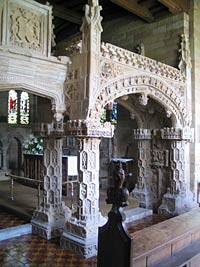< Previous | Contents | Next >
The Babes in the Barrels

Kingston-on-Soar church in 2006.

Kingston-on-Soar Hall, c.1910.
KINGSTON-ON-SOAR. It is a place of lovely trees. Firs and pines and cedars line the road by Kingston Park, and from the line gates to the hall is a charming view of spinneys and wooded hills. Stately giants completely embower the three-cornered green, round which are gathered the old village pump, a crescent of cottages with mullioned windows and pointed eaves, and the charming little church, its lychgate set in a wall which ends in a stone bridge spanning a stream from the Wolds. A long row of old dwellings and the beginning of the great park complete this scene of rural peace. For the last hundred years Kingston has owed much to the Belpers. The first Lord Belper, a grandson of Jedediah Strutt of hosiery fame, built the stately hall, setting it on an eminence in the park with lovely grounds and a lake filled by the stream. Its entrance hall is famed for its alabaster columns, made from gypsum mined on the estate. After a long life devoted to business, science, and public service, Lord Belper was laid to rest here in 1880, and we read on his memorial:
Keep innocency, and take heed to the
thing that is right, for that shall
bring a man peace at the last.
One of his sons was Frederick Strutt, a naturalist and archaeologist who has been sleeping in the churchyard since 1909. He was mayor of Derby, and left a valuable collection of local books, maps, and prints. His brother, second Lord Belper, refashioned the church, giving it the dainty embattled tower, and its nave and aisle, divided by arches on clustered pillars. He restored the chancel with its fine medieval sedilia, and rich glass glows in his memory. He also rebuilt the Gothic chapel with the old material.

The Babington monument in 2006.
It is in this chapel that the fame of the church lies. Built by the Babingtons 400 years ago, it has an unusual bow window adorned with arms and badges of Babingtons, Ferrers, Stanhopes, and Belpers. Its great possession, unique in the county for the richness of its decoration, is a pillared canopy like an archway, through which we can walk from the chapel to the chancel. It was probably meant to stand over a tomb. In its extraordinary mass of fine carving, of wonderful variety, are shields and trailing vines, and about 200 tiny figures of babes in tuns, representing the family name in sculpture. Among them are 28 boys and girls forming a kind of ring-of-roses round each of two capitals, all in playful spirit. On the other two capitals the babes are sitting sedately with their barrels. Other quaint figures and heads peep from the magnificent panelling of the pillars, and on the wall is a fine carving of the Last Judgment, with the battered figure of Our Lord, Michael and Gabriel with trumpets, coffins giving up their dead, the saved climbing to the gates of heaven, and the lost falling into the jaws of a fearful monster.
Sir Anthony Babington of 1544 is said to have erected this monument, but it is another Anthony of whom we think as we stand before it. Young, rich, and handsome, an ardent Roman Catholic, he is said to have hidden for a time on the top of this canopy after the discovery of the plot which cost him his life. Born at Dethick in Derbyshire in 1561, he was beheaded when he was only 25 for his share in the conspiracy to put Mary Queen of Scots on the throne.
At a farm here was born in 1716 a man who was to become famous and to live through most of the century. He was John Berridge, a wealthy farmer's son who studied hard at Cambridge (often working 15 hours a day) and became an evangelist, preaching to people on village greens and in barns. We read that he sent out preaching "gardeners, collar-makers, and shopkeepers." He came in touch with Wesley and Whitefield, and John Wesley called him "one of the most simple as well as the most sensible men." Tall, kindly, and witty, he drew immense crowds to listen to him. He lies in the shadow of the church at which he was vicar when he died at Everton in Bedfordshire.
On the edge of the village are the fine buildings of the Midland Agricultural College which were once used as prison camps for German officers. One of them was the famous Von Muller of the Emden, whose story was among the first exciting chapters of the war.
